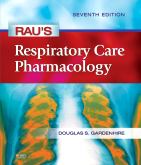|
|
|
| |
 |
|
|

|
 推薦指數:
推薦指數:





|
|
- 內容介紹
|
Rau's Respiratory Care Pharmacology, 7th Edition
By Douglas S. Gardenhire, EdD(c), RRT
544 pages 159 ills
Trim size 8 X 10 in
Copyright 2008
Description
Celebrating its 30th year in publication, the new edition of this classic resource boasts enhanced readability, a full-color design, and a new author who brings a fresh perspective on respiratory care pharmacology. This authoritative book provides essential, need-to-know information about respiratory pharmacology in an easy-to-understand format that simplifies complex concepts and prepares you for practice. Completely updated, this edition includes the most recent FDA approved medications and reflects the current state of respiratory care practice in today's health care environment.
Key Features
Logically organized and easy-to-read, this resource provides complete coverage of pharmacokinetic principles as they relate to respiratory care.
Offers a solid foundation in the basics of respiratory care pharmacology with information on the principles of drug action, the basic methods of drug administration, standard drug calculations, and the effects of drugs on body systems.
Includes comprehensive information on the drugs most frequently delivered to patients by respiratory therapists.
Provides concise coverage of the drugs used to treat critical care and cardiovascular patients.
New to this Edition
Handpicked by Joseph Rau, new author Douglas Gardenhire brings a fresh, new perspective on respiratory care pharmacology.
Completely updated and revised, this book provides you with coverage of the most recent FDA approved medications and prepares you for a career as a respiratory care professional in today's health care environment. Drug updates are posted to Evolve as they become available.
More readable than ever, this edition features a simplified presentation to help you more easily grasp complex concepts.
A new full-color design and vivid illustrations enhance readability, clarify key concepts and help you quickly locate important information.
Learning objectives at the start of each chapter parallel the recall, analysis, and application levels tested on the NBRC exam to help you prepare for certification.
Key terms with definitions at the beginning of each chapter help you master essential terminology.
Key Points boxes help you identify the most important concepts presented in each chapter.
Table of Contents
Unit I: Basic Concepts and Principles in Pharmacology
1. Introduction to Respiratory Care Pharmacology
2. Principles of Drug Action
3. Administration of Aerosolized Agents
4. Calculating Drug Doses
5. The Central and Peripheral Nervous System
Unit II: Drugs Used to Treat the Respiratory System
6. Adrenergic (Sympathomimetic) Bronchodilators
7. Anticholinergic (Parasympatholytic) Bronchodilators
8. Xanthines
9. Mucus-Controlling Drug Therapy
10. Surfactant Agents
11. Corticosteriods in Respiratory Care
12. Nonsteroidal Antiasthma Agents
13. Aerosolized Antiinfective Agents
14. Antimicrobial Agents
15. Cold and Cough Agents
16. Selected Agents of Pulmonary Value
17. Neonatal and Pediatric Aerosolized Drug Therapy
Unit III: Critical Care and Cardiovascular Drug Classes
18. Skeletal Muscle Relaxants (Neuromuscular Blocking Agents)
19. Vasopressors, Inotropes and Antiarrhythmic Agents
20. Drugs Affecting Circulation: Antihypertensives, Antianginals, Antithrombotics
21. Diuretic Agents
22. Drugs Affecting the Central Nervous System
Appendix A: Answers to Assessment Questions and Clinical Scenarios
Appendix B: Units and Systems of Measurement
Appendix C: Recommendations on the Use of Aerosol Generators
Appendix D: Pharmacological Management of Asthma and Chronic Obstructive Pulmonary Disease
|
|
|

